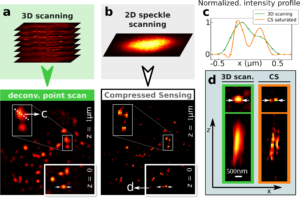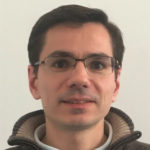Awards, News
The “Institut Universitaire de France” supports “singular microscopy”

Comparison of regular 3D point scanning microscopy (a) with super-resolution compressed sensing microscopy with speckle patterns (b). Super-resolution was achieved here by saturating fluorescence excitation. (From M. Pascucci et al., Nat. Comm. 2019).
Congratulations to Dr. Marc Guillon for his nomination as a junior member of the “Institut Universitaire de France” (IUF)
Dr. Marc Guillon will be appointed as a junior member at IUF in Oct. 2019. This appointment is aiming at promoting his novel research line in microscopy. For the past few years, MG has been exploiting fundamental optics – such as “singular optics” – for optical instrumentation and bio-imaging. Very recently, he could demonstrate the possibility to take advantage of “compressed sensing” for performing efficient 3D super-resolution microscopy [1]. This work relied on two main fundamental features of speckles: their 3D intensity statistics, and their intrinsic high spatial density of “optical vortices” such as used for STED nanoscopy and that allow breaking the diffraction limit. His current projects mostly rely on fully exploiting speckles’ properties to perform optimized microscopy, with the mid-term perspective to image in-depth in tissues.
Page of Marc Guillon, team of Marc Guillon.
[1] Compressive three-dimensional super-resolution microscopy with speckle-saturated fluorescence excitation, M. Pascucci, S. Ganesan, A. Tripathi, O. Katz, V. Emiliani, M. Guillon, Nat. Commun. 10, 1327 (2019).
